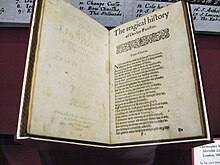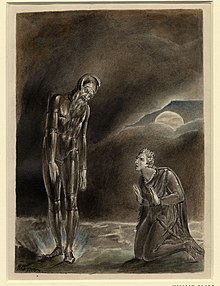Shakespearean tragedy

Shakespearean tragedy is the designation given to most
Shakespearean comedies. Almost three centuries after Shakespeare's death, the scholar F. S. Boas also coined a fifth category, the "problem play," for plays that do not fit neatly into a single classification because of their subject matter, setting, or ending.[1][2]
Scholars continue to disagree on how to categorize some Shakespearean plays.
Chronology

Below is the list of Shakespeare's plays listed as
tragedies in the First Folio, along with the date range in which each play is believed to have been written.[1][3]
| Play | Terminus | |
|---|---|---|
| post quem | ante quem | |
| Titus Andronicus | 1591 | 1593 |
| Romeo and Juliet | 1594 | 1595 |
| Julius Caesar | 1599 | 1600 |
| Hamlet | 1600 | 1601 |
| Troilus and Cressida[a] | 1601 | 1602 |
| Othello | 1604 | 1605 |
| King Lear | 1605 | 1606 |
| Macbeth | 1605 | 1606 |
| Timon of Athens | 1605 | 1608 |
| Antony and Cleopatra | 1606 | 1607 |
| Coriolanus | 1607 | 1608 |
Influences and sources

The
Giraldi Cintio.[1] The historical basis for Shakespeare's Roman plays comes from The Lives of Noble Grecians and Romans by Plutarch,[5] whereas the source of Shakespeare's Britain-based plays and Hamlet (based on the Danish Prince Amleth)[6] derive from Holinshed's Chronicles.[1] Furthermore, the French author Belleforest published The Hystorie of Hamblet, Prince of Denmarke in 1582, which includes specifics from how the prince pretended madness, to how the prince stabbed and killed the King's counsellor who was eavesdropping on Hamlet and his mother behind the arras in the Queen's chamber.[6] The story of Lear appears in Geoffrey of Monmouth's Historia regium Britanniae c. 1135, and then in John Higgins' poem The Mirror for Magistrates in 1574, as well as appearing in Holinshed's Chronicles in 1587.[7] Some events that happen in Shakespeare's King Lear were inspired by various episodes of Philip Sidney's Arcadia from 1590, while the nonsensical musings of Edgar's "poor Tom" heavily reference Samuel Harsnett's 1603 book, A Declaration of Egregious Popish Impostures.[7]
Contemporary tragedy

Tragedies from these eras traced their philosophical essence back to the
morality plays which, by this time, were outlawed by Elizabeth I. One marked difference between English renaissance tragedies and the classics that inspired them was the use and popularity of violence and murder on stage.[1]
Select exemplary (non-Shakespearean) Elizabethan and Jacobean tragedies:[6]
- The Spanish Tragedy by Thomas Kyd
- The Jew of Malta by Christopher Marlowe
- Tamburlaine by Christopher Marlowe
- Doctor Faustus by Christopher Marlowe
- Antonio's Revenge by John Marston
- The Revenger's Tragedy by Thomas Middleton
- 'Tis Pity She's a Whore by John Ford
Notes and references
Notes
- ^ Troilus and Cressida was listed as a comedy in the First Folio, but is now classified as a tragedy.
References
- ^ a b c d e f g h i Dunton-Downer & Riding 2004.
- ^ a b Boas 1910, pp. 344–408.
- ^ a b Brockett & Hildy 2007, p. 109.
- ^ Bryson 2007, p. 99.
- ^ Mowat & Werstine 2013.
- ^ a b c Hoy 1992.
- ^ a b Foakes 1997.
- ^ "Shakespeare and the Tragic Virtue". www.jsu.edu. Archived from the original on 21 May 2018. Retrieved 3 May 2018.
Sources
- OCLC 939680633.
- Brockett, Oscar G.; Hildy, Franklin J. (2007). History of Theatre (9th ed.). Boston: ISBN 978-0205358786.
- OCLC 136782567.
- Dunton-Downer, Leslie; Riding, Alan (2004). Essential Shakespeare Handbook. New York: ISBN 978-0789493330.
- ISBN 1903436591.
- ISBN 978-0-393-31642-1.
- ISBN 978-1-4391-9671-7.
Further reading
- Boyce, Charles (1990). Shakespeare A to Z. New York: Roundtable Press. ISBN 0-440-50429-5.
- ISBN 978-0-393-92991-1.
- Jamieson, Lee (1 May 2015). "Shakespeare Tragedies". About.com. Retrieved 4 April 2014.
- McEachern, Claire, ed. (2013). The Cambridge Companion to Shakespearean Tragedy. Cambridge Companions to Literature. Cambridge: ISBN 978-0511999314.

